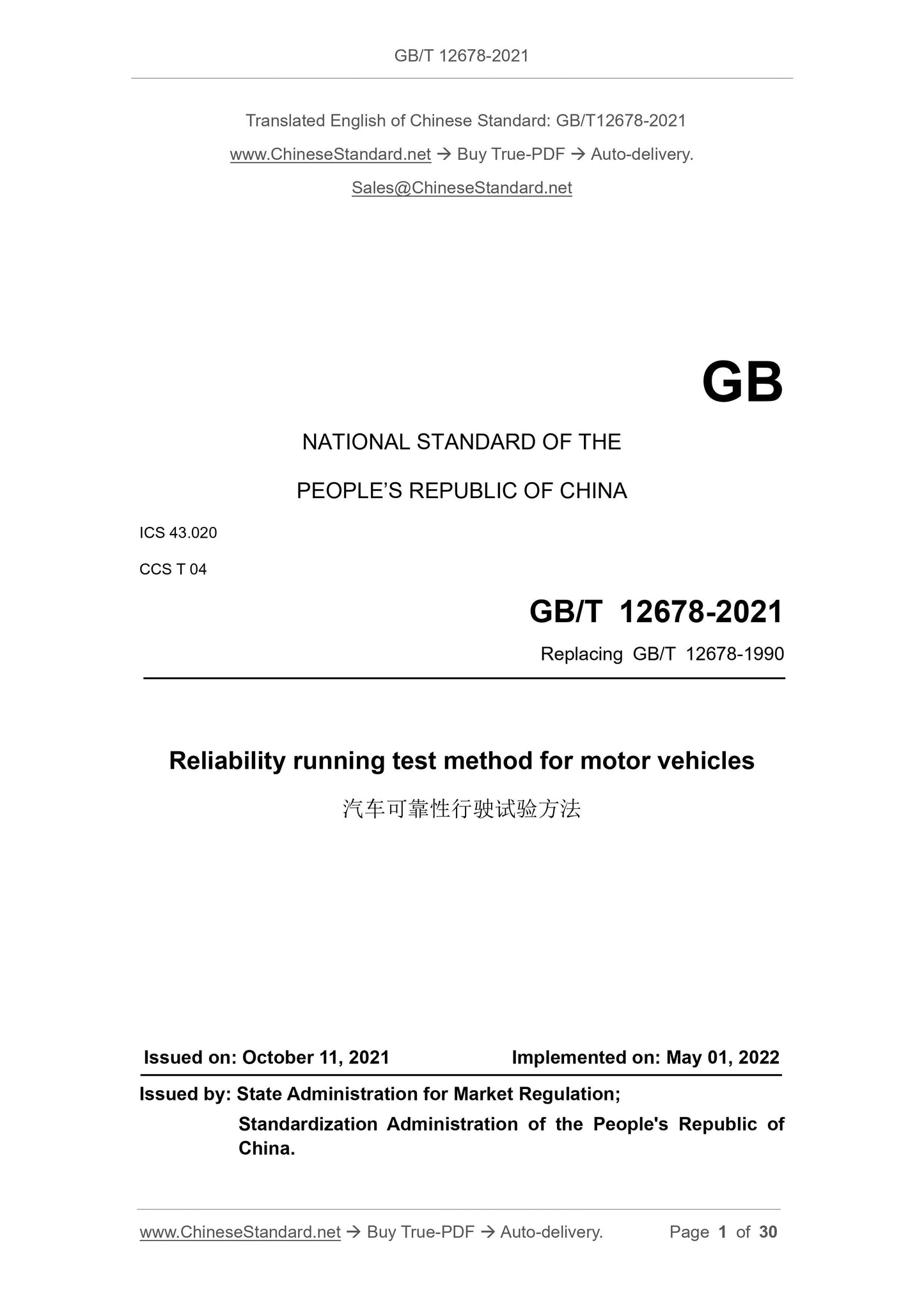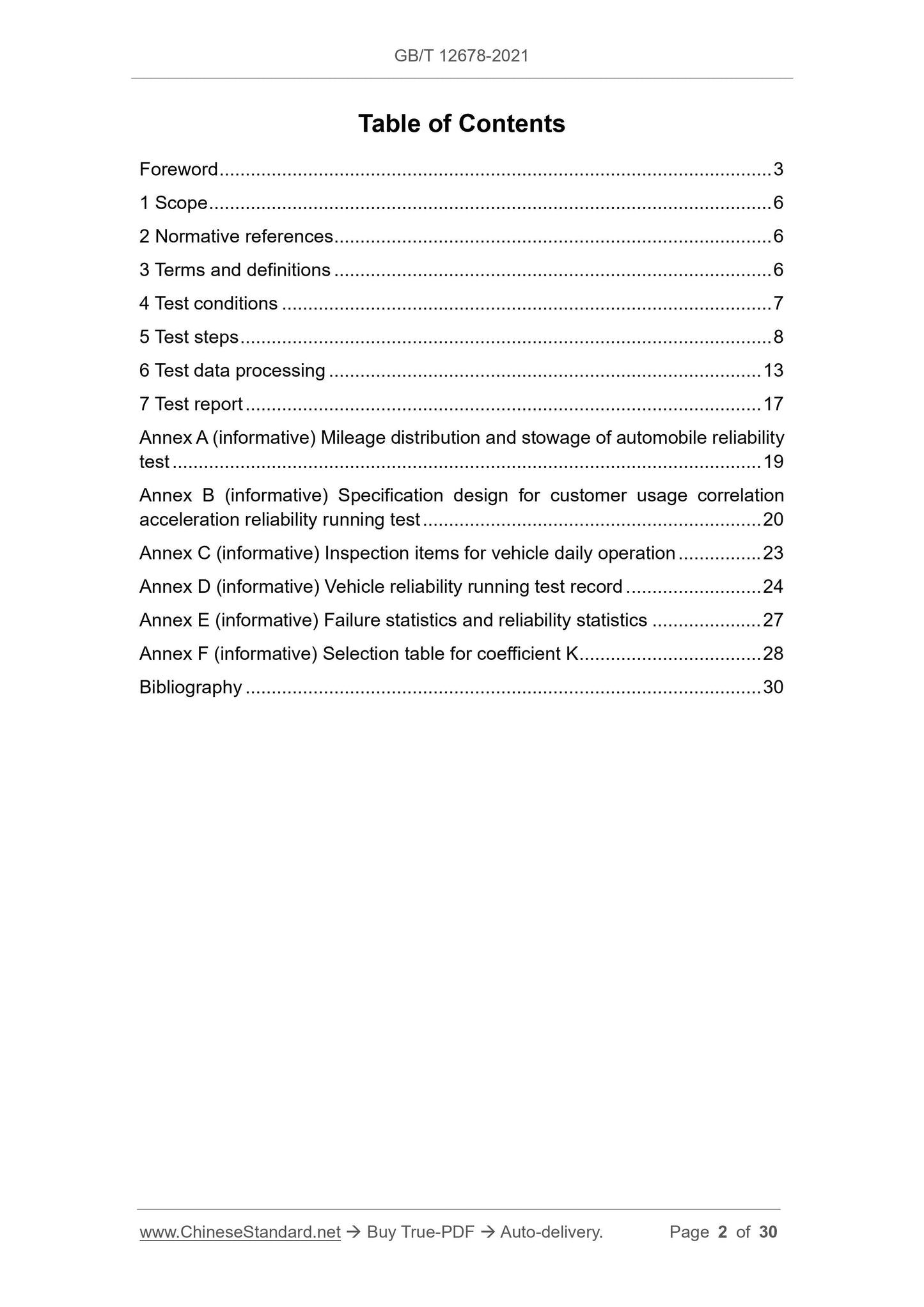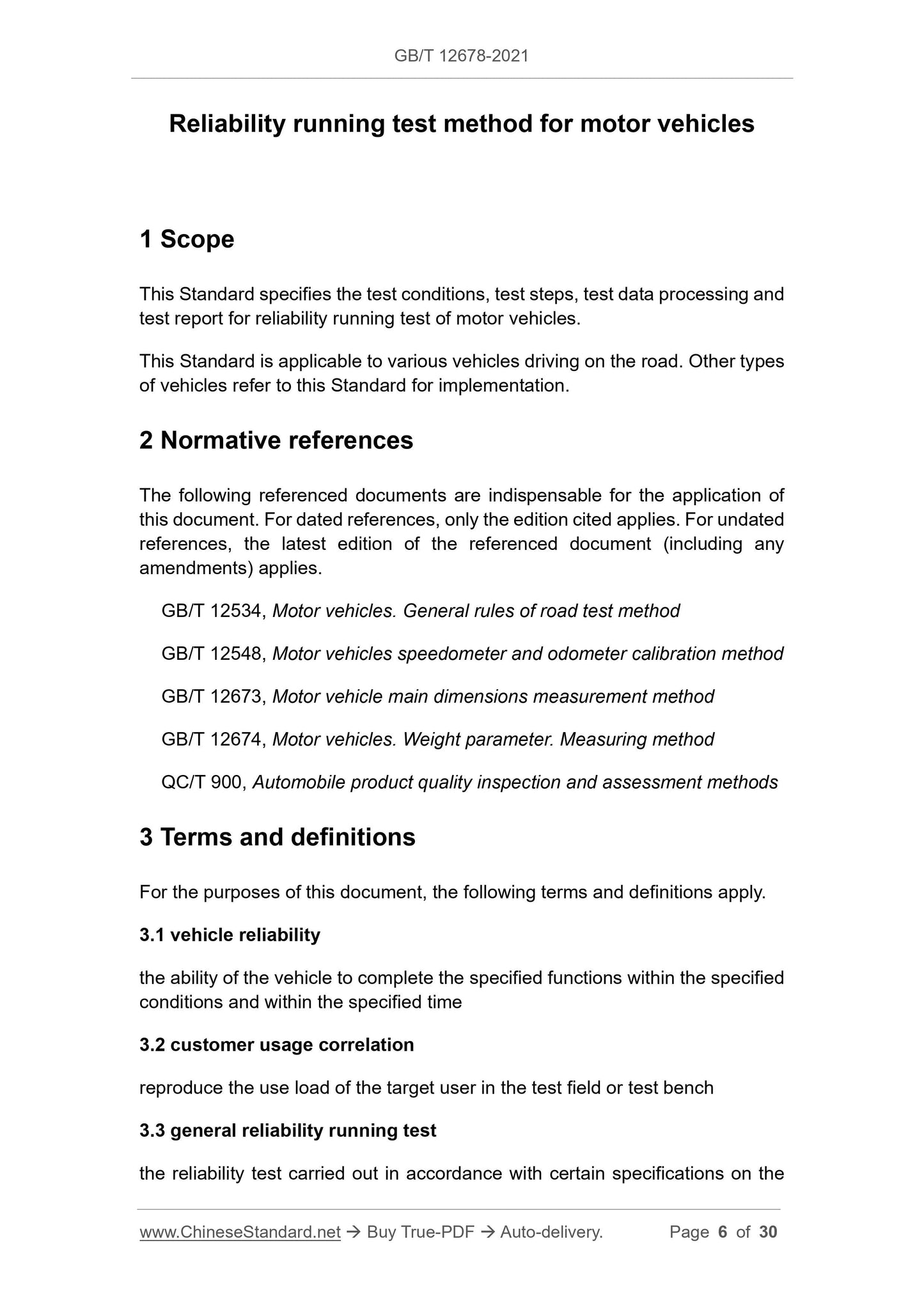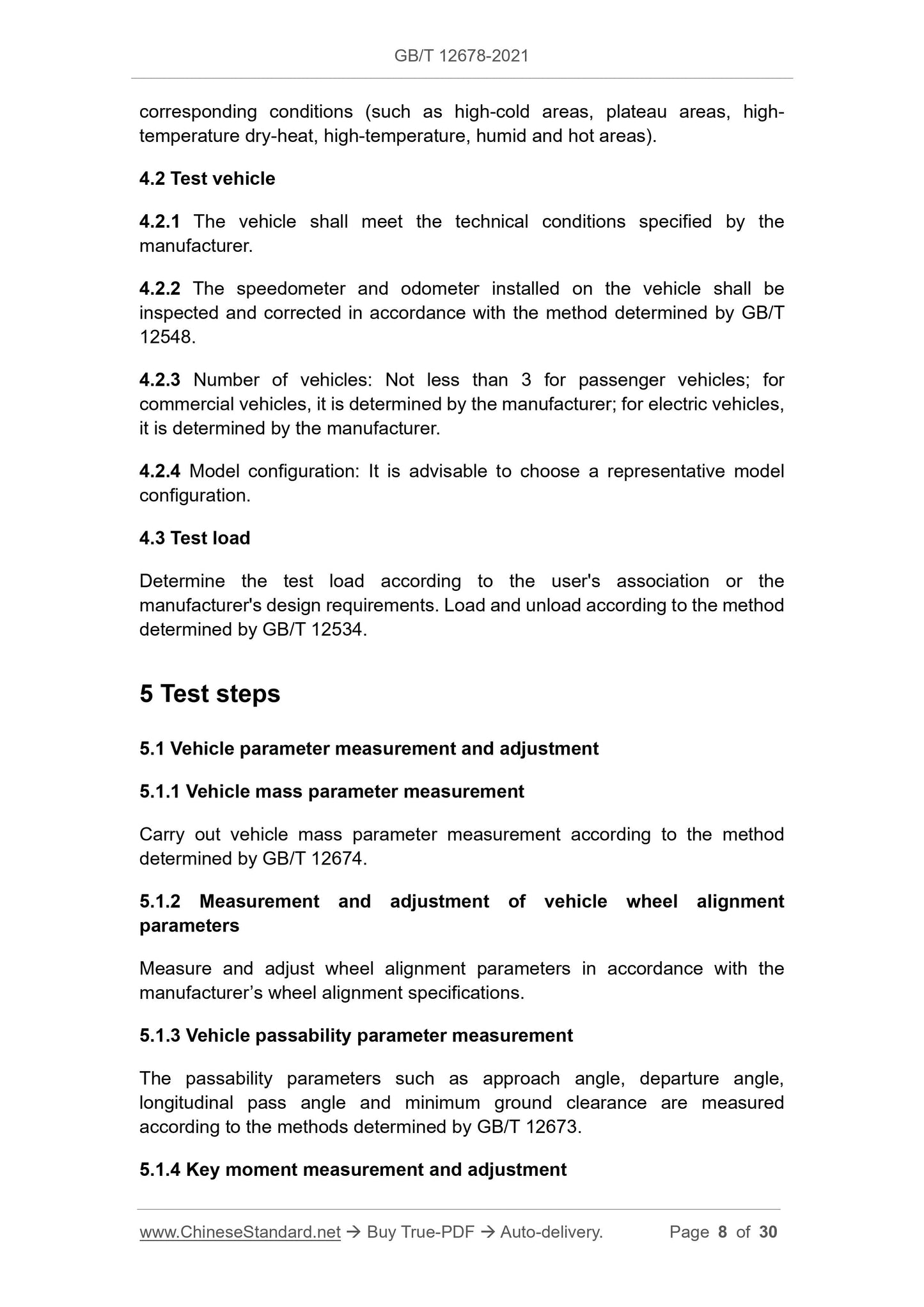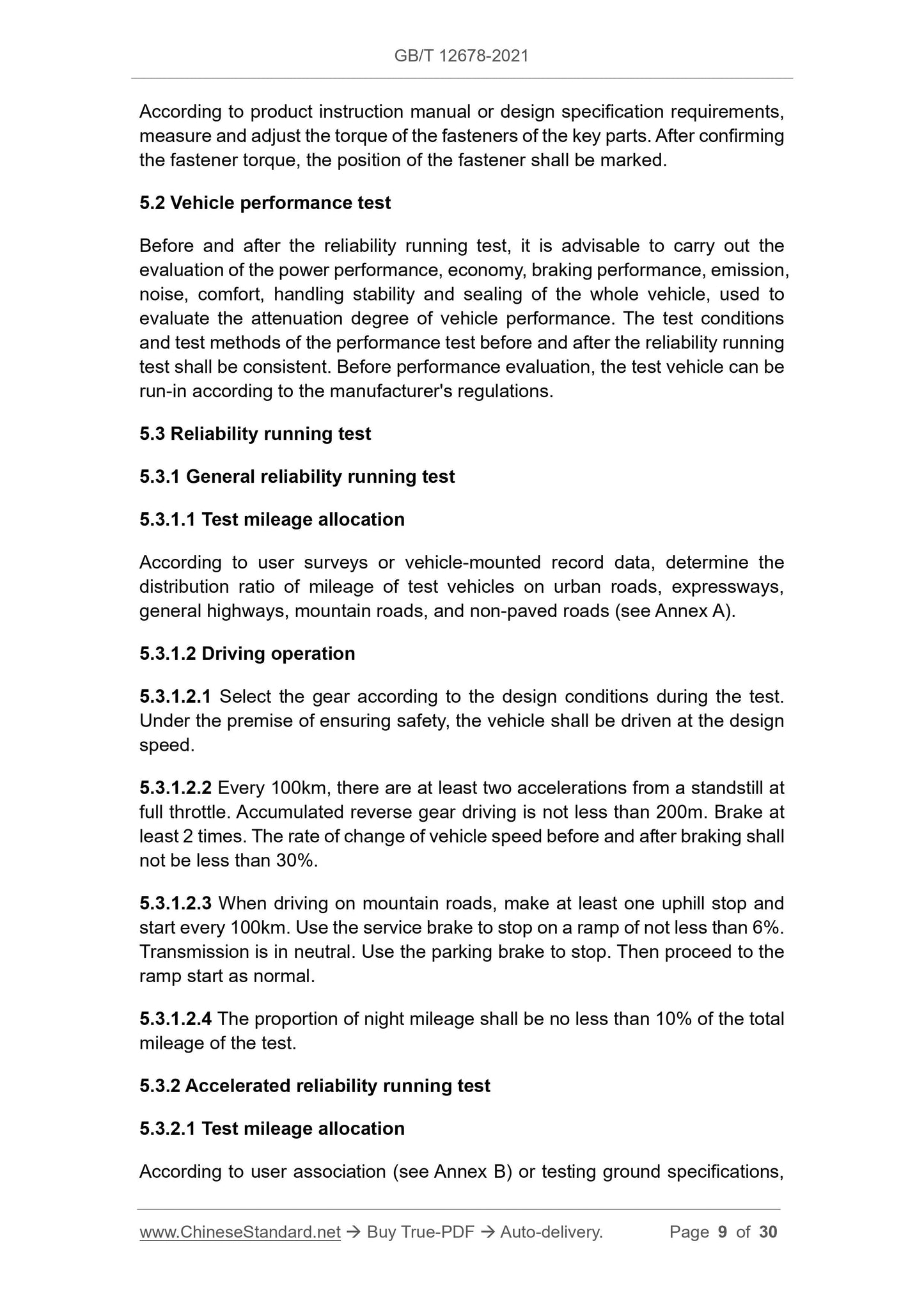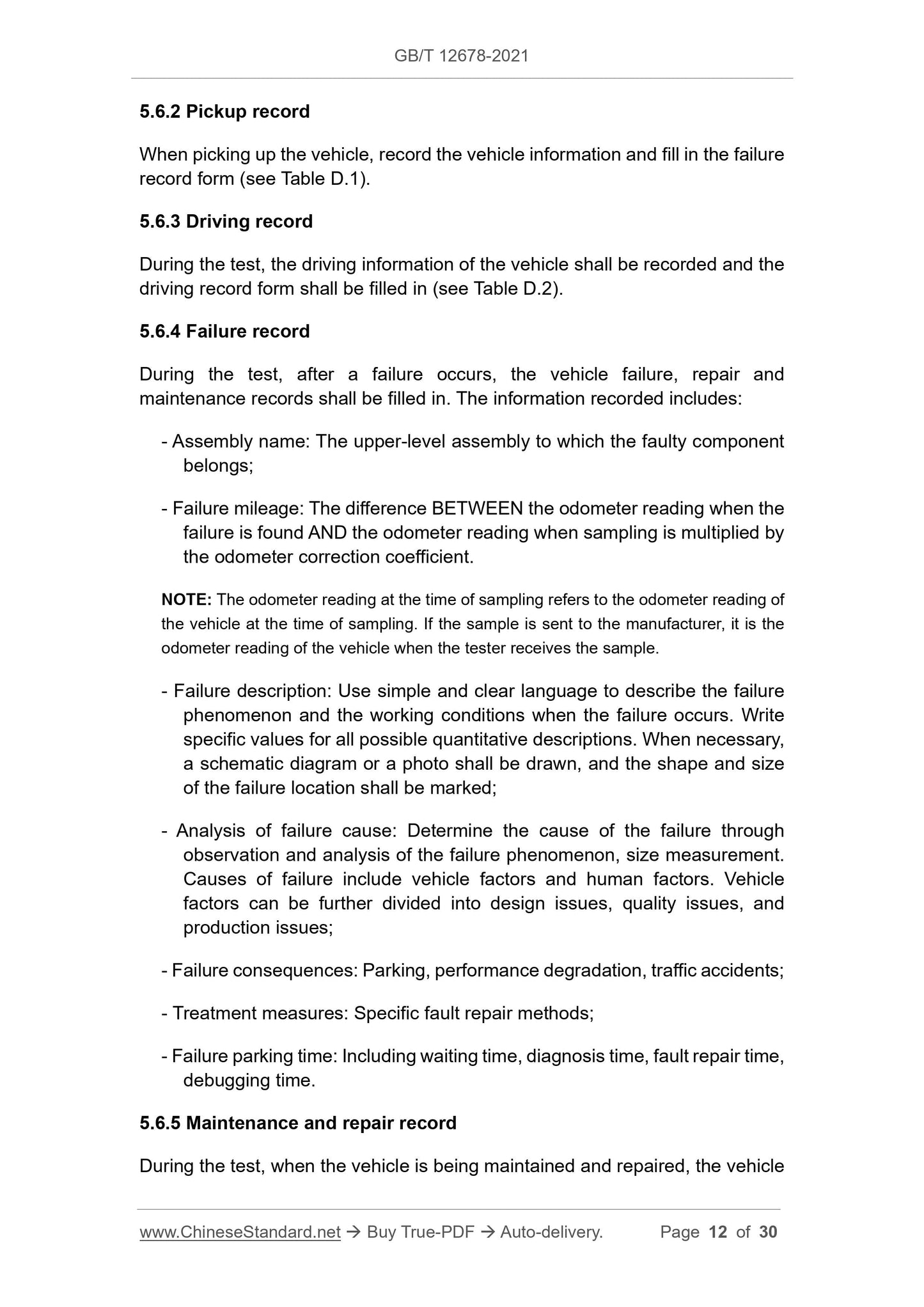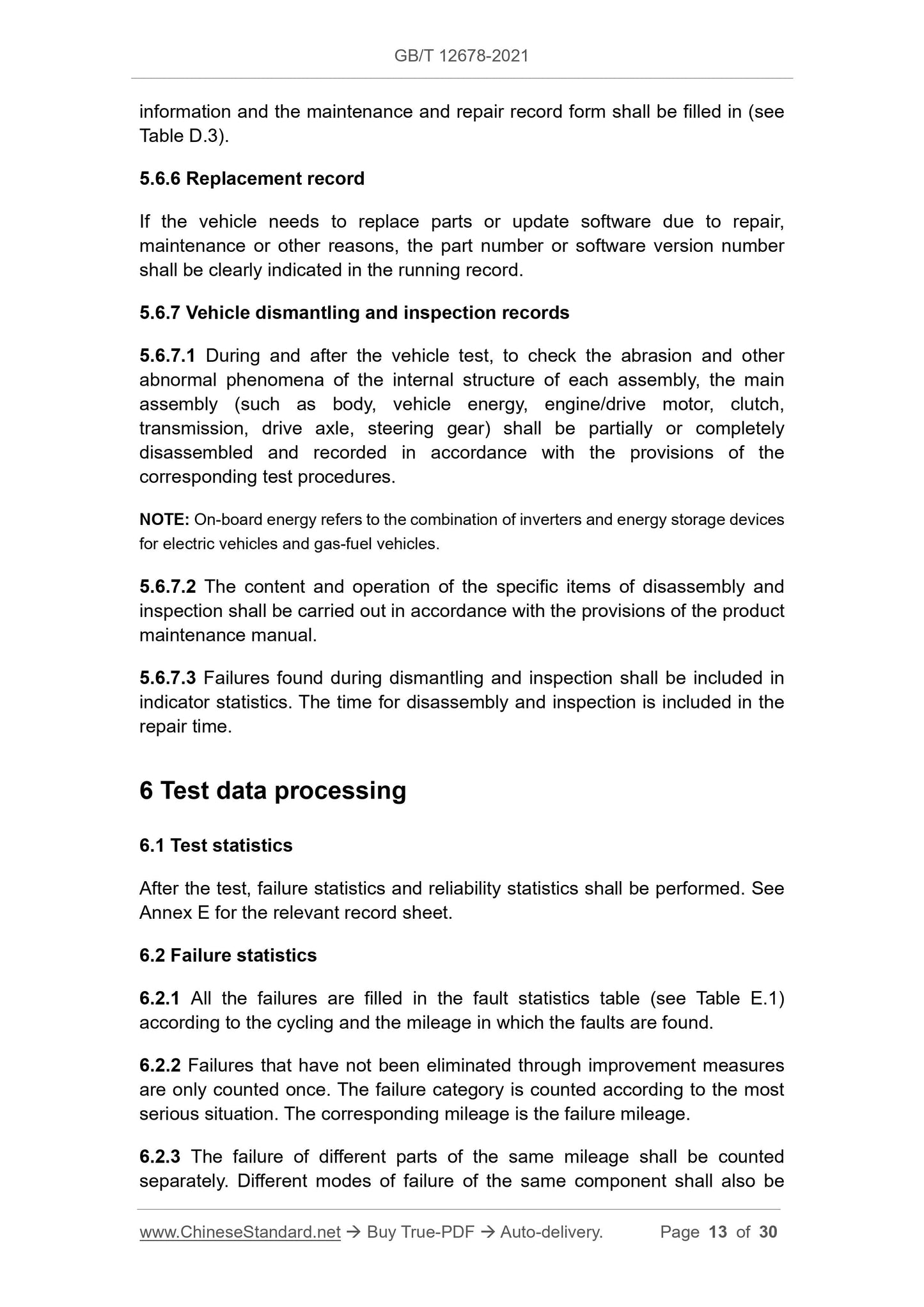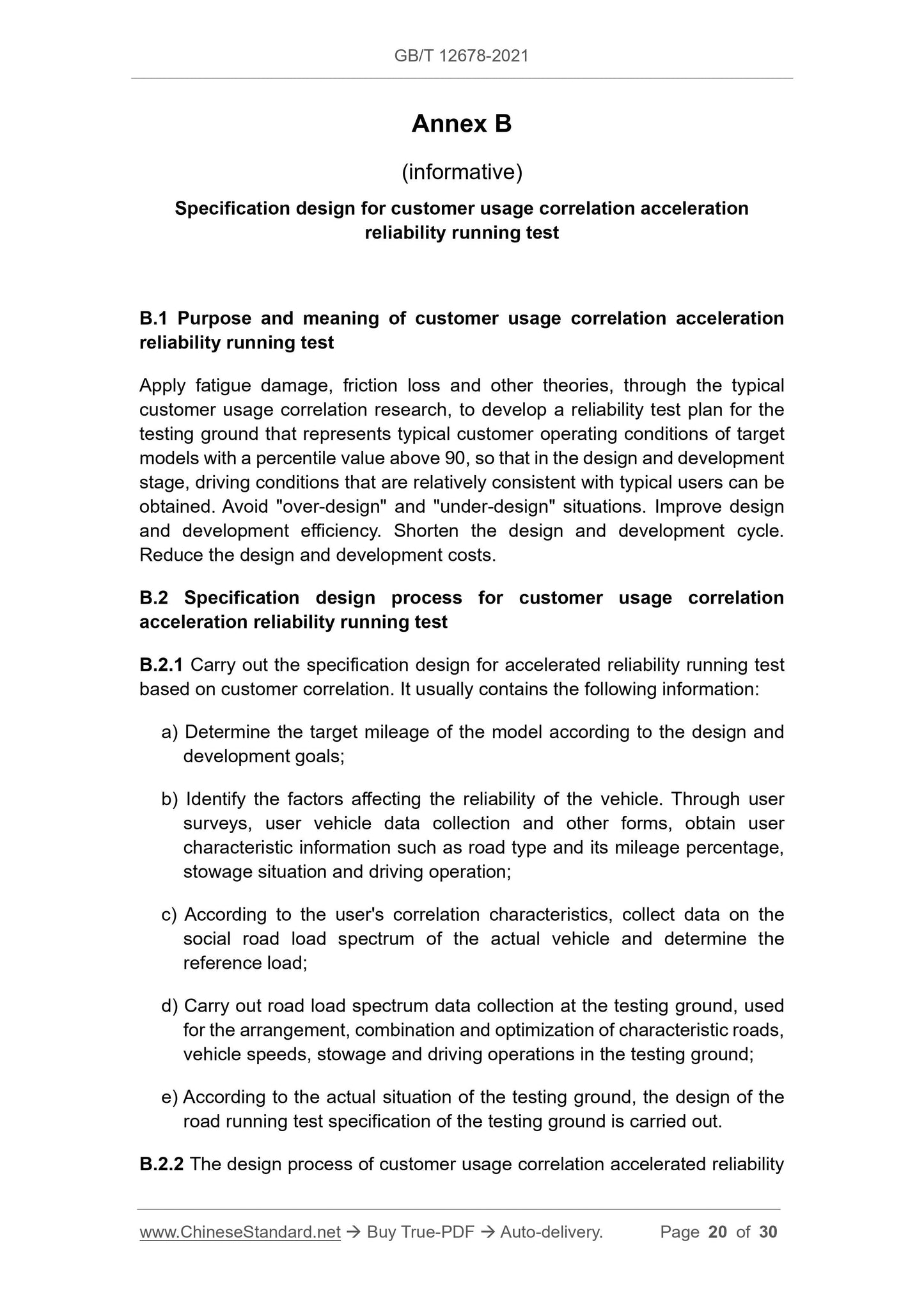1
/
of
8
www.ChineseStandard.us -- Field Test Asia Pte. Ltd.
GB/T 12678-2021 English PDF (GB/T12678-2021)
GB/T 12678-2021 English PDF (GB/T12678-2021)
Regular price
$320.00
Regular price
Sale price
$320.00
Unit price
/
per
Shipping calculated at checkout.
Couldn't load pickup availability
GB/T 12678-2021: Reliability running test method for motor vehicles
Delivery: 9 seconds. Download (& Email) true-PDF + Invoice.
Get Quotation: Click GB/T 12678-2021 (Self-service in 1-minute)
Historical versions (Master-website): GB/T 12678-2021
Preview True-PDF (Reload/Scroll-down if blank)
GB/T 12678-2021
GB
NATIONAL STANDARD OF THE
PEOPLE’S REPUBLIC OF CHINA
ICS 43.020
CCS T 04
Replacing GB/T 12678-1990
Reliability running test method for motor vehicles
ISSUED ON: OCTOBER 11, 2021
IMPLEMENTED ON: MAY 01, 2022
Issued by: State Administration for Market Regulation;
Standardization Administration of the People's Republic of
China.
Table of Contents
Foreword ... 3
1 Scope ... 6
2 Normative references ... 6
3 Terms and definitions ... 6
4 Test conditions ... 7
5 Test steps ... 8
6 Test data processing ... 13
7 Test report ... 17
Annex A (informative) Mileage distribution and stowage of automobile reliability
test ... 19
Annex B (informative) Specification design for customer usage correlation
acceleration reliability running test ... 20
Annex C (informative) Inspection items for vehicle daily operation ... 23
Annex D (informative) Vehicle reliability running test record ... 24
Annex E (informative) Failure statistics and reliability statistics ... 27
Annex F (informative) Selection table for coefficient K ... 28
Bibliography ... 30
Reliability running test method for motor vehicles
1 Scope
This Standard specifies the test conditions, test steps, test data processing and
test report for reliability running test of motor vehicles.
This Standard is applicable to various vehicles driving on the road. Other types
of vehicles refer to this Standard for implementation.
2 Normative references
The following referenced documents are indispensable for the application of
this document. For dated references, only the edition cited applies. For undated
references, the latest edition of the referenced document (including any
amendments) applies.
GB/T 12534, Motor vehicles. General rules of road test method
GB/T 12548, Motor vehicles speedometer and odometer calibration method
GB/T 12673, Motor vehicle main dimensions measurement method
GB/T 12674, Motor vehicles. Weight parameter. Measuring method
QC/T 900, Automobile product quality inspection and assessment methods
3 Terms and definitions
For the purposes of this document, the following terms and definitions apply.
3.1 vehicle reliability
the ability of the vehicle to complete the specified functions within the specified
conditions and within the specified time
3.2 customer usage correlation
reproduce the use load of the target user in the test field or test bench
3.3 general reliability running test
the reliability test carried out in accordance with certain specifications on the
corresponding conditions (such as high-cold areas, plateau areas, high-
temperature dry-heat, high-temperature, humid and hot areas).
4.2 Test vehicle
4.2.1 The vehicle shall meet the technical conditions specified by the
manufacturer.
4.2.2 The speedometer and odometer installed on the vehicle shall be
inspected and corrected in accordance with the method determined by GB/T
12548.
4.2.3 Number of vehicles: Not less than 3 for passenger vehicles; for
commercial vehicles, it is determined by the manufacturer; for electric vehicles,
it is determined by the manufacturer.
4.2.4 Model configuration: It is advisable to choose a representative model
configuration.
4.3 Test load
Determine the test load according to the user's association or the
manufacturer's design requirements. Load and unload according to the method
determined by GB/T 12534.
5 Test steps
5.1 Vehicle parameter measurement and adjustment
5.1.1 Vehicle mass parameter measurement
Carry out vehicle mass parameter measurement according to the method
determined by GB/T 12674.
5.1.2 Measurement and adjustment of vehicle wheel alignment
parameters
Measure and adjust wheel alignment parameters in accordance with the
manufacturer’s wheel alignment specifications.
5.1.3 Vehicle passability parameter measurement
The passability parameters such as approach angle, departure angle,
longitudinal pass angle and minimum ground clearance are measured
according to the methods determined by GB/T 12673.
5.1.4 Key moment measurement and adjustment
According to product instruction manual or design specification requirements,
measure and adjust the torque of the fasteners of the key parts. After confirming
the fastener torque, the position of the fastener shall be marked.
5.2 Vehicle performance test
Before and after the reliability running test, it is advisable to carry out the
evaluation of the power performance, economy, braking performance, emission,
noise, comfort, handling stability and sealing of the whole vehicle, used to
evaluate the attenuation degree of vehicle performance. The test conditions
and test methods of the performance test before and after the reliability running
test shall be consistent. Before performance evaluation, the test vehicle can be
run-in according to the manufacturer's regulations.
5.3 Reliability running test
5.3.1 General reliability running test
5.3.1.1 Test mileage allocation
According to user surveys or vehicle-mounted record data, determine the
distribution ratio of mileage of test vehicles on urban roads, expressways,
general highways, mountain roads, and non-paved roads (see Annex A).
5.3.1.2 Driving operation
5.3.1.2.1 Select the gear according to the design conditions during the test.
Under the premise of ensuring safety, the vehicle shall be driven at the design
speed.
5.3.1.2.2 Every 100km, there are at least two accelerations from a standstill at
full throttle. Accumulated reverse gear driving is not less than 200m. Brake at
least 2 times. The rate of change of vehicle speed before and after braking shall
not be less than 30%.
5.3.1.2.3 When driving on mountain roads, make at least one uphill stop and
start every 100km. Use the service brake to stop on a ramp of not less than 6%.
Transmission is in neutral. Use the parking brake to stop. Then proceed to the
ramp start as normal.
5.3.1.2.4 The proportion of night mileage shall be no less than 10% of the total
mileage of the test.
5.3.2 Accelerated reliability running test
5.3.2.1 Test mileage allocation
According to user association (see Annex B) or testing ground specifications,
5.6.2 Pickup record
When picking up the vehicle, record the vehicle information and fill in the failure
record form (see Table D.1).
5.6.3 Driving record
During the test, the driving information of the vehicle shall be recorded and the
driving record form shall be filled in (see Table D.2).
5.6.4 Failure record
During the test, after a failure occurs, the vehicle failure, repair and
maintenance records shall be filled in. The information recorded includes:
- Assembly name: The upper-level assembly to which the faulty component
belongs;
- Failure mileage: The difference BETWEEN the odometer reading when the
failure is found AND the odometer reading when sampling is multiplied by
the odometer correction coefficient.
NOTE: The odometer reading at the time of sampling refers to the odometer reading of
the vehicle at the time of sampling. If the sample is sent to the manufacturer, it is the
odometer reading of the vehicle when the tester receives the sample.
- Failure description: Use simple and clear language to describe the failure
phenomenon and the working conditions when the failure occurs. Write
specific values for all possible quantitative descriptions. When necessary,
a schematic diagram or a photo shall be drawn, and the shape and size
of the failure location shall be marked;
- Analysis of failure cause: Determine the cause of the failure through
observation and analysis of the failure phenomenon, size measurement.
Causes of failure include vehicle factors and human factors. Vehicle
factors can be further divided into design issues, quality issues, and
production issues;
- Failure consequences: Parking, performance degradation, traffic accidents;
- Treatment measures: Specific fault repair methods;
- Failure parking time: Including waiting time, diagnosis time, fault repair time,
debugging time.
5.6.5 Maintenance and repair record
During the test, when the vehicle is being maintained and repaired, the vehicle
information and the maintenance and repair record form shall be filled in (see
Table D.3).
5.6.6 Replacement record
If the vehicle needs to replace parts or update software due to repair,
maintenance or other reasons, the part number or software version number
shall be clearly indicated in the running record.
5.6.7 Vehicle dismantling and inspection records
5.6.7.1 During and after the vehicle test, to check the abrasion and other
abnormal phenomena of the internal structure of each assembly, the main
assembly (such as body, vehicle energy, engine/drive motor, clutch,
transmission, drive axle, steering gear) shall be partially or completely
disassembled and recorded in accordance with the provisions of the
corresponding test procedures.
NOTE: On-board energy refers to the combination of inverters and energy storage devices
for electric vehicles and gas-fuel vehicles.
5.6.7.2 The content and operation of the specific items of disassembly and
inspection shall be carried out in accordance with the provisions of the product
maintenance manual.
5.6.7.3 Failures found during dismantling and inspection shall be included in
indicator statistics. The time for disassembly and inspection is included in the
repair time.
6 Test data processing
6.1 Test statistics
After the test, failure statistics and reliability statistics shall be performed. See
Annex E for the relevant record sheet.
6.2 Failure statistics
6.2.1 All the failures are filled in the fault statistics table (see Table E.1)
according to the cycling and the mileage in which the faults are found.
6.2.2 Failures that have not been eliminated through improvement measures
are only counted once. The failure category is counted according to the most
serious situation. The corresponding mileage is the failure mileage.
6.2.3 The failure of different parts of the same mileage shall be counted
separately. Different modes of failure of the same component shall also be
Annex B
(informative)
Specification design for customer usage correlation acceleration
reliability running test
B.1 Purpose and meaning of customer usage correlation acceleration
reliability running test
Apply fatigue damage, friction loss and other theories, through the typical
customer usage correlation research, to develop a reliability test plan for the
testing ground that represents typical customer operating conditions of target
models with a percentile value above 90, so that in the design and development
stage, driving conditions that are relatively consistent with typical users can be
obtained. Avoid "over-design" and "under-design" situations. Improve design
and development efficiency. Shorten the design and development cycle.
Reduce the design and development costs.
B.2 Specification design process for customer usage correlation
acceleration reliability running test
B.2.1 Carry out the specification design for accelerated reliability running test
based on customer correlation. It usually contains the following information:
a) Determine the target mileage of the model according to the design and
development goals;
b) Identify the factors affecting the reliability of the vehicle. Through user
surveys, user vehicle data collection and other forms, obtain user
characteristic information such as road type and its mileage percentage,
stowage situation and driving operation;
c) According to the user's correlation characteristics, collect data on the
social road load spectrum of the actual vehicle and determine the
reference load;
d) Carry out road load spectrum data collection at the testing ground, used
for the arrangement, combination and optimization of characteristic roads,
vehicle speeds, stowage and driving operations in the testing ground;
e) According to the actual situation of the testing ground, the design of the
road running test specification of the testing ground is carried out.
B.2.2 The design process of customer usage correlation accelerated reliability
GB/T 12678-2021
GB
NATIONAL STANDARD OF THE
PEOPLE’S REPUBLIC OF CHINA
ICS 43.020
CCS T 04
Replacing GB/T 12678-1990
Reliability running test method for motor vehicles
ISSUED ON: OCTOBER 11, 2021
IMPLEMENTED ON: MAY 01, 2022
Issued by: State Administration for Market Regulation;
Standardization Administration of the People's Republic of
China.
Table of Contents
Foreword ... 3
1 Scope ... 6
2 Normative references ... 6
3 Terms and definitions ... 6
4 Test conditions ... 7
5 Test steps ... 8
6 Test data processing ... 13
7 Test report ... 17
Annex A (informative) Mileage distribution and stowage of automobile reliability
test ... 19
Annex B (informative) Specification design for customer usage correlation
acceleration reliability running test ... 20
Annex C (informative) Inspection items for vehicle daily operation ... 23
Annex D (informative) Vehicle reliability running test record ... 24
Annex E (informative) Failure statistics and reliability statistics ... 27
Annex F (informative) Selection table for coefficient K ... 28
Bibliography ... 30
Reliability running test method for motor vehicles
1 Scope
This Standard specifies the test conditions, test steps, test data processing and
test report for reliability running test of motor vehicles.
This Standard is applicable to various vehicles driving on the road. Other types
of vehicles refer to this Standard for implementation.
2 Normative references
The following referenced documents are indispensable for the application of
this document. For dated references, only the edition cited applies. For undated
references, the latest edition of the referenced document (including any
amendments) applies.
GB/T 12534, Motor vehicles. General rules of ...
Delivery: 9 seconds. Download (& Email) true-PDF + Invoice.
Get Quotation: Click GB/T 12678-2021 (Self-service in 1-minute)
Historical versions (Master-website): GB/T 12678-2021
Preview True-PDF (Reload/Scroll-down if blank)
GB/T 12678-2021
GB
NATIONAL STANDARD OF THE
PEOPLE’S REPUBLIC OF CHINA
ICS 43.020
CCS T 04
Replacing GB/T 12678-1990
Reliability running test method for motor vehicles
ISSUED ON: OCTOBER 11, 2021
IMPLEMENTED ON: MAY 01, 2022
Issued by: State Administration for Market Regulation;
Standardization Administration of the People's Republic of
China.
Table of Contents
Foreword ... 3
1 Scope ... 6
2 Normative references ... 6
3 Terms and definitions ... 6
4 Test conditions ... 7
5 Test steps ... 8
6 Test data processing ... 13
7 Test report ... 17
Annex A (informative) Mileage distribution and stowage of automobile reliability
test ... 19
Annex B (informative) Specification design for customer usage correlation
acceleration reliability running test ... 20
Annex C (informative) Inspection items for vehicle daily operation ... 23
Annex D (informative) Vehicle reliability running test record ... 24
Annex E (informative) Failure statistics and reliability statistics ... 27
Annex F (informative) Selection table for coefficient K ... 28
Bibliography ... 30
Reliability running test method for motor vehicles
1 Scope
This Standard specifies the test conditions, test steps, test data processing and
test report for reliability running test of motor vehicles.
This Standard is applicable to various vehicles driving on the road. Other types
of vehicles refer to this Standard for implementation.
2 Normative references
The following referenced documents are indispensable for the application of
this document. For dated references, only the edition cited applies. For undated
references, the latest edition of the referenced document (including any
amendments) applies.
GB/T 12534, Motor vehicles. General rules of road test method
GB/T 12548, Motor vehicles speedometer and odometer calibration method
GB/T 12673, Motor vehicle main dimensions measurement method
GB/T 12674, Motor vehicles. Weight parameter. Measuring method
QC/T 900, Automobile product quality inspection and assessment methods
3 Terms and definitions
For the purposes of this document, the following terms and definitions apply.
3.1 vehicle reliability
the ability of the vehicle to complete the specified functions within the specified
conditions and within the specified time
3.2 customer usage correlation
reproduce the use load of the target user in the test field or test bench
3.3 general reliability running test
the reliability test carried out in accordance with certain specifications on the
corresponding conditions (such as high-cold areas, plateau areas, high-
temperature dry-heat, high-temperature, humid and hot areas).
4.2 Test vehicle
4.2.1 The vehicle shall meet the technical conditions specified by the
manufacturer.
4.2.2 The speedometer and odometer installed on the vehicle shall be
inspected and corrected in accordance with the method determined by GB/T
12548.
4.2.3 Number of vehicles: Not less than 3 for passenger vehicles; for
commercial vehicles, it is determined by the manufacturer; for electric vehicles,
it is determined by the manufacturer.
4.2.4 Model configuration: It is advisable to choose a representative model
configuration.
4.3 Test load
Determine the test load according to the user's association or the
manufacturer's design requirements. Load and unload according to the method
determined by GB/T 12534.
5 Test steps
5.1 Vehicle parameter measurement and adjustment
5.1.1 Vehicle mass parameter measurement
Carry out vehicle mass parameter measurement according to the method
determined by GB/T 12674.
5.1.2 Measurement and adjustment of vehicle wheel alignment
parameters
Measure and adjust wheel alignment parameters in accordance with the
manufacturer’s wheel alignment specifications.
5.1.3 Vehicle passability parameter measurement
The passability parameters such as approach angle, departure angle,
longitudinal pass angle and minimum ground clearance are measured
according to the methods determined by GB/T 12673.
5.1.4 Key moment measurement and adjustment
According to product instruction manual or design specification requirements,
measure and adjust the torque of the fasteners of the key parts. After confirming
the fastener torque, the position of the fastener shall be marked.
5.2 Vehicle performance test
Before and after the reliability running test, it is advisable to carry out the
evaluation of the power performance, economy, braking performance, emission,
noise, comfort, handling stability and sealing of the whole vehicle, used to
evaluate the attenuation degree of vehicle performance. The test conditions
and test methods of the performance test before and after the reliability running
test shall be consistent. Before performance evaluation, the test vehicle can be
run-in according to the manufacturer's regulations.
5.3 Reliability running test
5.3.1 General reliability running test
5.3.1.1 Test mileage allocation
According to user surveys or vehicle-mounted record data, determine the
distribution ratio of mileage of test vehicles on urban roads, expressways,
general highways, mountain roads, and non-paved roads (see Annex A).
5.3.1.2 Driving operation
5.3.1.2.1 Select the gear according to the design conditions during the test.
Under the premise of ensuring safety, the vehicle shall be driven at the design
speed.
5.3.1.2.2 Every 100km, there are at least two accelerations from a standstill at
full throttle. Accumulated reverse gear driving is not less than 200m. Brake at
least 2 times. The rate of change of vehicle speed before and after braking shall
not be less than 30%.
5.3.1.2.3 When driving on mountain roads, make at least one uphill stop and
start every 100km. Use the service brake to stop on a ramp of not less than 6%.
Transmission is in neutral. Use the parking brake to stop. Then proceed to the
ramp start as normal.
5.3.1.2.4 The proportion of night mileage shall be no less than 10% of the total
mileage of the test.
5.3.2 Accelerated reliability running test
5.3.2.1 Test mileage allocation
According to user association (see Annex B) or testing ground specifications,
5.6.2 Pickup record
When picking up the vehicle, record the vehicle information and fill in the failure
record form (see Table D.1).
5.6.3 Driving record
During the test, the driving information of the vehicle shall be recorded and the
driving record form shall be filled in (see Table D.2).
5.6.4 Failure record
During the test, after a failure occurs, the vehicle failure, repair and
maintenance records shall be filled in. The information recorded includes:
- Assembly name: The upper-level assembly to which the faulty component
belongs;
- Failure mileage: The difference BETWEEN the odometer reading when the
failure is found AND the odometer reading when sampling is multiplied by
the odometer correction coefficient.
NOTE: The odometer reading at the time of sampling refers to the odometer reading of
the vehicle at the time of sampling. If the sample is sent to the manufacturer, it is the
odometer reading of the vehicle when the tester receives the sample.
- Failure description: Use simple and clear language to describe the failure
phenomenon and the working conditions when the failure occurs. Write
specific values for all possible quantitative descriptions. When necessary,
a schematic diagram or a photo shall be drawn, and the shape and size
of the failure location shall be marked;
- Analysis of failure cause: Determine the cause of the failure through
observation and analysis of the failure phenomenon, size measurement.
Causes of failure include vehicle factors and human factors. Vehicle
factors can be further divided into design issues, quality issues, and
production issues;
- Failure consequences: Parking, performance degradation, traffic accidents;
- Treatment measures: Specific fault repair methods;
- Failure parking time: Including waiting time, diagnosis time, fault repair time,
debugging time.
5.6.5 Maintenance and repair record
During the test, when the vehicle is being maintained and repaired, the vehicle
information and the maintenance and repair record form shall be filled in (see
Table D.3).
5.6.6 Replacement record
If the vehicle needs to replace parts or update software due to repair,
maintenance or other reasons, the part number or software version number
shall be clearly indicated in the running record.
5.6.7 Vehicle dismantling and inspection records
5.6.7.1 During and after the vehicle test, to check the abrasion and other
abnormal phenomena of the internal structure of each assembly, the main
assembly (such as body, vehicle energy, engine/drive motor, clutch,
transmission, drive axle, steering gear) shall be partially or completely
disassembled and recorded in accordance with the provisions of the
corresponding test procedures.
NOTE: On-board energy refers to the combination of inverters and energy storage devices
for electric vehicles and gas-fuel vehicles.
5.6.7.2 The content and operation of the specific items of disassembly and
inspection shall be carried out in accordance with the provisions of the product
maintenance manual.
5.6.7.3 Failures found during dismantling and inspection shall be included in
indicator statistics. The time for disassembly and inspection is included in the
repair time.
6 Test data processing
6.1 Test statistics
After the test, failure statistics and reliability statistics shall be performed. See
Annex E for the relevant record sheet.
6.2 Failure statistics
6.2.1 All the failures are filled in the fault statistics table (see Table E.1)
according to the cycling and the mileage in which the faults are found.
6.2.2 Failures that have not been eliminated through improvement measures
are only counted once. The failure category is counted according to the most
serious situation. The corresponding mileage is the failure mileage.
6.2.3 The failure of different parts of the same mileage shall be counted
separately. Different modes of failure of the same component shall also be
Annex B
(informative)
Specification design for customer usage correlation acceleration
reliability running test
B.1 Purpose and meaning of customer usage correlation acceleration
reliability running test
Apply fatigue damage, friction loss and other theories, through the typical
customer usage correlation research, to develop a reliability test plan for the
testing ground that represents typical customer operating conditions of target
models with a percentile value above 90, so that in the design and development
stage, driving conditions that are relatively consistent with typical users can be
obtained. Avoid "over-design" and "under-design" situations. Improve design
and development efficiency. Shorten the design and development cycle.
Reduce the design and development costs.
B.2 Specification design process for customer usage correlation
acceleration reliability running test
B.2.1 Carry out the specification design for accelerated reliability running test
based on customer correlation. It usually contains the following information:
a) Determine the target mileage of the model according to the design and
development goals;
b) Identify the factors affecting the reliability of the vehicle. Through user
surveys, user vehicle data collection and other forms, obtain user
characteristic information such as road type and its mileage percentage,
stowage situation and driving operation;
c) According to the user's correlation characteristics, collect data on the
social road load spectrum of the actual vehicle and determine the
reference load;
d) Carry out road load spectrum data collection at the testing ground, used
for the arrangement, combination and optimization of characteristic roads,
vehicle speeds, stowage and driving operations in the testing ground;
e) According to the actual situation of the testing ground, the design of the
road running test specification of the testing ground is carried out.
B.2.2 The design process of customer usage correlation accelerated reliability
GB/T 12678-2021
GB
NATIONAL STANDARD OF THE
PEOPLE’S REPUBLIC OF CHINA
ICS 43.020
CCS T 04
Replacing GB/T 12678-1990
Reliability running test method for motor vehicles
ISSUED ON: OCTOBER 11, 2021
IMPLEMENTED ON: MAY 01, 2022
Issued by: State Administration for Market Regulation;
Standardization Administration of the People's Republic of
China.
Table of Contents
Foreword ... 3
1 Scope ... 6
2 Normative references ... 6
3 Terms and definitions ... 6
4 Test conditions ... 7
5 Test steps ... 8
6 Test data processing ... 13
7 Test report ... 17
Annex A (informative) Mileage distribution and stowage of automobile reliability
test ... 19
Annex B (informative) Specification design for customer usage correlation
acceleration reliability running test ... 20
Annex C (informative) Inspection items for vehicle daily operation ... 23
Annex D (informative) Vehicle reliability running test record ... 24
Annex E (informative) Failure statistics and reliability statistics ... 27
Annex F (informative) Selection table for coefficient K ... 28
Bibliography ... 30
Reliability running test method for motor vehicles
1 Scope
This Standard specifies the test conditions, test steps, test data processing and
test report for reliability running test of motor vehicles.
This Standard is applicable to various vehicles driving on the road. Other types
of vehicles refer to this Standard for implementation.
2 Normative references
The following referenced documents are indispensable for the application of
this document. For dated references, only the edition cited applies. For undated
references, the latest edition of the referenced document (including any
amendments) applies.
GB/T 12534, Motor vehicles. General rules of ...
Share
